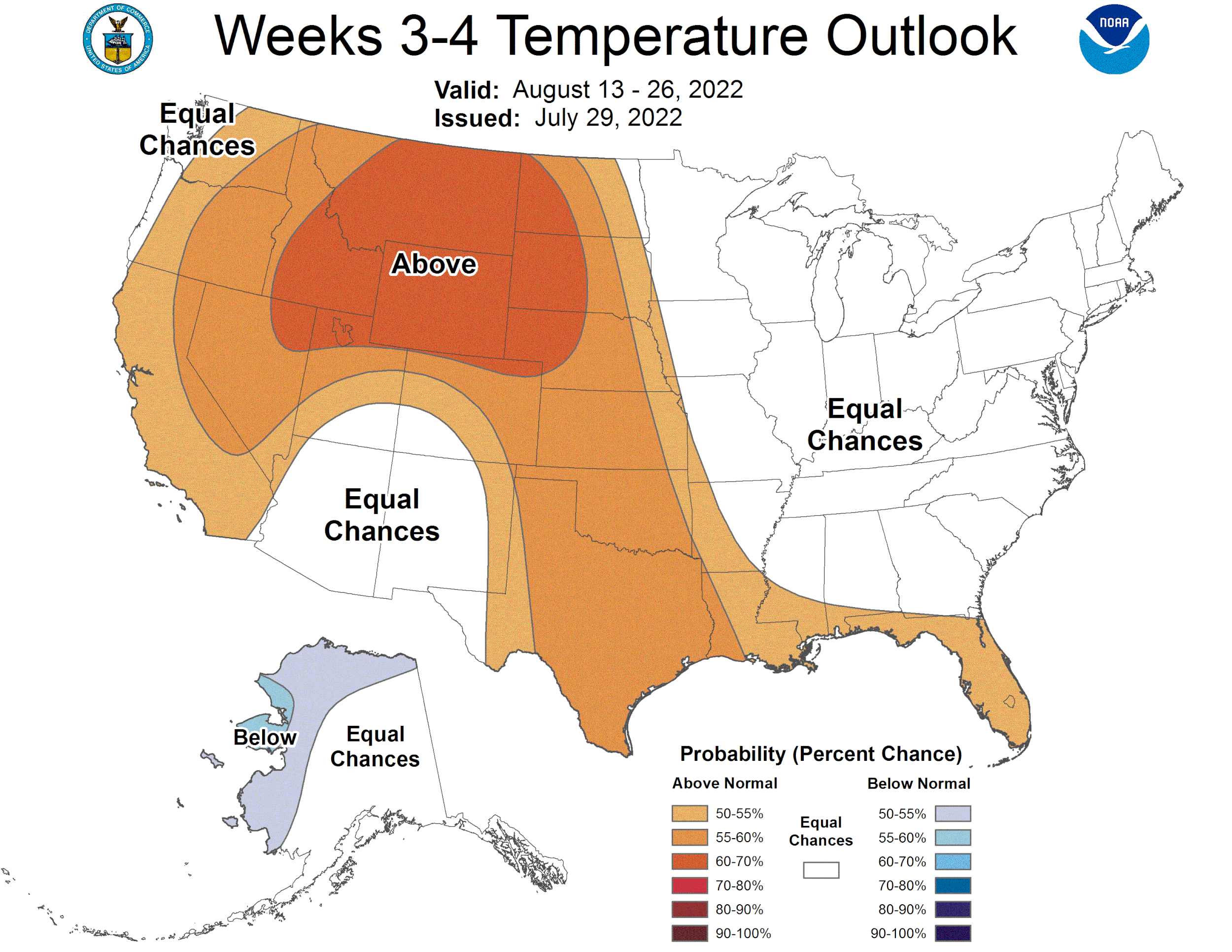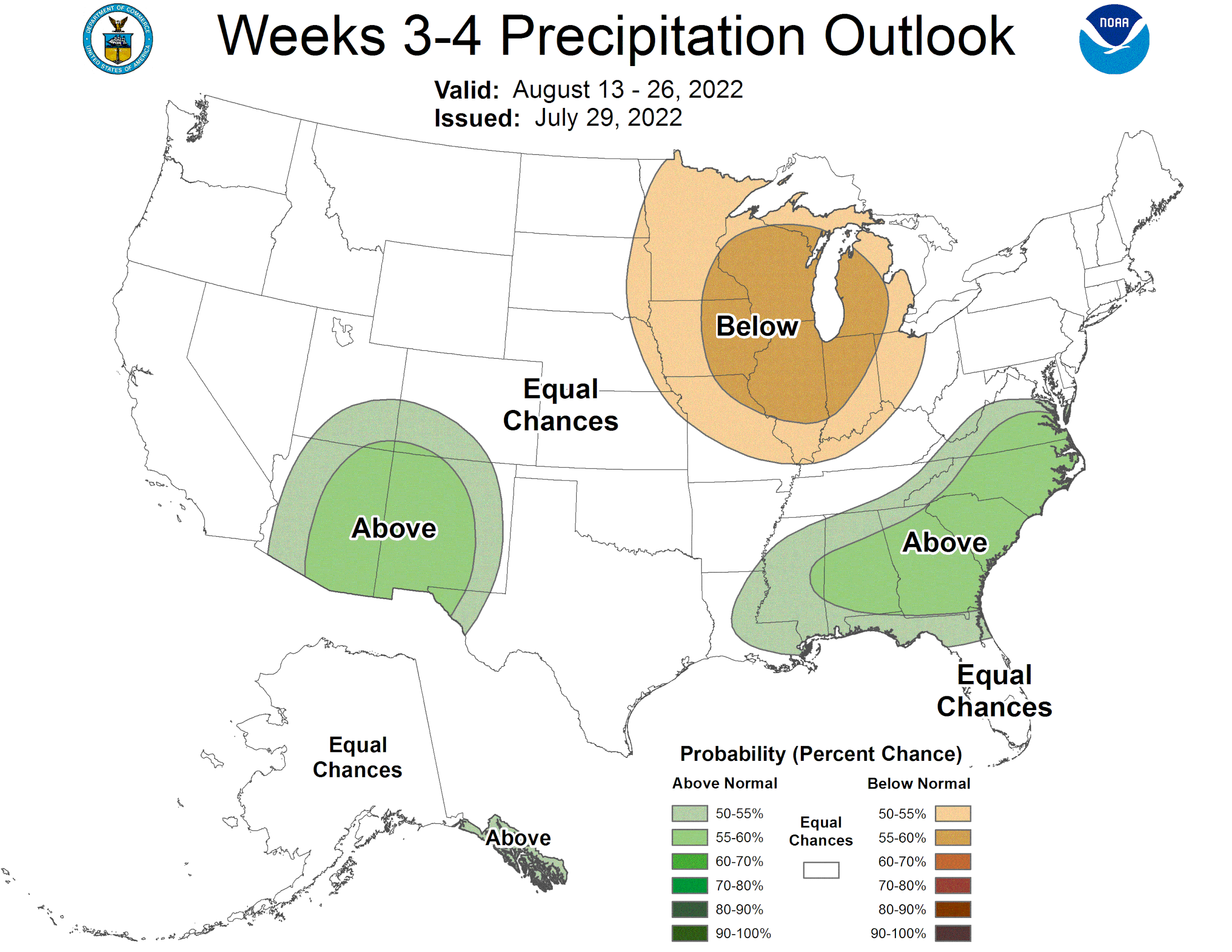MORNING MARKET UPDATE
Updates on Ukraine, Taiwan, and Weather
Futures Prices 9:30am CT
Overview
Grains are higher this morning following prices being lower the last two days to start the week, following level crop conditions. Beans held the support levels of their 20-day moving average. With corn and wheat trading below theirs.
A major question is what will we see out of Ukraine after their first shipment left Monday, and will we continue to see them export grain?
Other headlines include Nancy Pelosi's decision to travel to Taiwan. The group left Taiwan today. The visit sparked some tension additional tension between China and the U.S. China also announced it would be banning new imports on +2,000 food products from Taiwan. We could likely see more bans to follow. awe will have to wait and see how this effects Chinese demand for U.S. exports.
U.S. weather forecasts continue to be more favorable for the eastern corn belt area. As there is expected rain as well as less heat than compared to the west. However, the drought conditions appear to still be having a big impact on growing regions in Europe.
Focus going forward will be looking towards the August 12th USDA Crop Report.
Today's Main Takeaways
Corn
Corn slightly higher to start the morning, following losses to start the week. The big question mark is surrounding the improved forecasts in areas of the eastern corn belt. As we've seen forecasts turn more favorable, with rain and less heat.
People also continue to talk about yield, with most suggesting we will actually see the U.S. yield lower, rather than higher. The current USDA projection is 177. However, some people are throwing out numbers closer to 175 or maybe even lower towards 172. It's tough to say, but there is some belief that the USDA hasn't quite factored in the past few months' drought conditions and little rainfall. Will be very interesting to see where crop conditions come in at next week.
A respected crop analyst Dr. Cordonnier lowered his U.S. corn yield projection by 1 bushel. Bringing his estimate to 174. While USDA has theirs remain at 177.
For right now, it appears there are more bearish factors than bullish ones. As markets continue to post lower highs. As we have all these headlines surrounding news Ukraine being able to export, recession and strength in the dollar, and weaker oil. There is however some bullish cards that could still possibly come into play. Such as if the weather forecasts turn less favorable, as well as the ongoing conflict going on in Ukraine.
Support for Dec-22 corn is currently looking to be around that $5.50 range.
Soybeans
Soybeans overnight and early into trade this morning were trading anywhere from 8-11 or so cents higher. However, have gave up all of those gains early into the morning here by 9:30 am CT. This is following a disastrous two days to begin the week for soybeans. Those two days gave up a majority of the massive rally we saw last week.
Some Nov. contracts traded a 5-session low in the overnight. But ultimately found support, trading roughly 20 cents off the lows. We still haven’t been able to push past yesterday's high and continue to see nearby resistance around $14.07
On the bearish side, we have to look at the slightly more favorable weather forecasts, as well as the possibility that we could see a resolution in Argentina, which would allow producers to sell the soybeans they have been holding for quite some time. As well as the news with Nancy Pelosi and whether this will affect Chinese demand.
It appears that Pelosi is now going to have a meeting with the Taiwan president. China claims that the U.S. has already damaged our relationship with these actions.
Nov-22 beans gave up a ton of their gains from last week. As they move down closer to our 200-day moving average. A close above or below the 200-day moving average will be a large impact on future direction. A close above would hopefully stop the bleeding for now, and build support. A close below could mean a whole lot more lower prices.
The USDA reported the U.S. crush in June was 174 million bushels of soybeans. Down from 181 million bushels in May, but far above last years June which was 162 million.
Soymeal & Soyoil
Soymeal down -0.7 to 402.4
Soyoil up +1.36 to 62.75
Wheat
Wheat rebounding nicely in the overnight and were trading higher early into the morning. However, have gave up majority of its gains here at 9:30 am CT. Wheat likely finding support in the remarks made by Ukraine's President, Volodymyr Zelenskiy. Where he basically dismissed the importance of the first shipment. Claiming it was only carrying a fraction of the grain that they need to help stabilize their economy. He also mentioned that it will take some more time to see if other shioe=ments will follow.
The Ukraine situation could really go both ways. We continue to see Ukraine exporting grain, or we don't. Will Russia continue to allow them to ship grain, and if so, how much.
We also have the Chinese demand situation and recession/inflation. For the U.S. the spring wheat crop looks fairly good, as it is far better than last year. There is still the belief that EU, Argentina, and India's crop production forecasts are set too high and could be lowered.
Other Markets
Crude oil initially recovered from overnight weakness. Was up nearly +$2. However, ultimately trading slightly lower. Currently at $93.88
Dollar index up +0.416 to 106.520
Dec Cotton up +0.50 to $95.31
Dow up +191
News
Turkey expects daily departures from Ukraine after its first grain shipment. As long as the agreement holds true.
The Ukrainian Grain Association raised their wheat production estimate by 8.3% to 20.8 million metric tons, and raised corn production estimates by 4.6% to 27.3 million metric tons.
Crop Analyst Dr. Cordonnier lowered his U.S. corn yield by 1 bushel to 174. (USDA estimates 177). He also lowered his soybean yield estimate by half a bushel. Bringing his estimate to 50.5, while the USDA remains at 51.5.
Germanys Rhine River water levels are so low, that barge capacity is limited to 25% of normal load. Ultimately making water transportation far more expensive.
Weather
Source: National Weather Service







